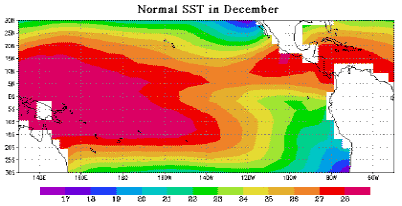|
Non El Niño Years
colder water in the eastern tropical Pacific
The easterly trade winds
of the tropics drag the surface waters
of the eastern Pacific away from the coastlines of the Americas.
As it moves away, the water is deflected northward (in the northern
hemisphere) by the Coriolis force and southward
(in the southern hemisphere), causing water to move away from the
equator in both directions.
Upwelling in the eastern Pacific
brings colder water up from deeper levels to replace the surface water
that has been dragged away.
Sea surface temperature (SST) data reveals the presence of colder water
in the eastern tropical Pacific.
The following plot of average sea surface temperatures from 1949-1993
shows that the average December SSTs were much cooler in the eastern Pacific
(less than 22 degrees Celsius) than in the western Pacific (greater than
25 degrees Celsius), gradually decreasing from west to east.

The trade winds
accumulate warm surface water around
Indonesia, raising the sea level roughly half a meter higher in the
western Pacific. As upwelling persists, the
level of the thermocline rises to shallower depths off
the South American coast and is depressed in the western Pacific.
The upwelled water is rich in nutrients and
supports an abundance of fish
and marine life.
|
